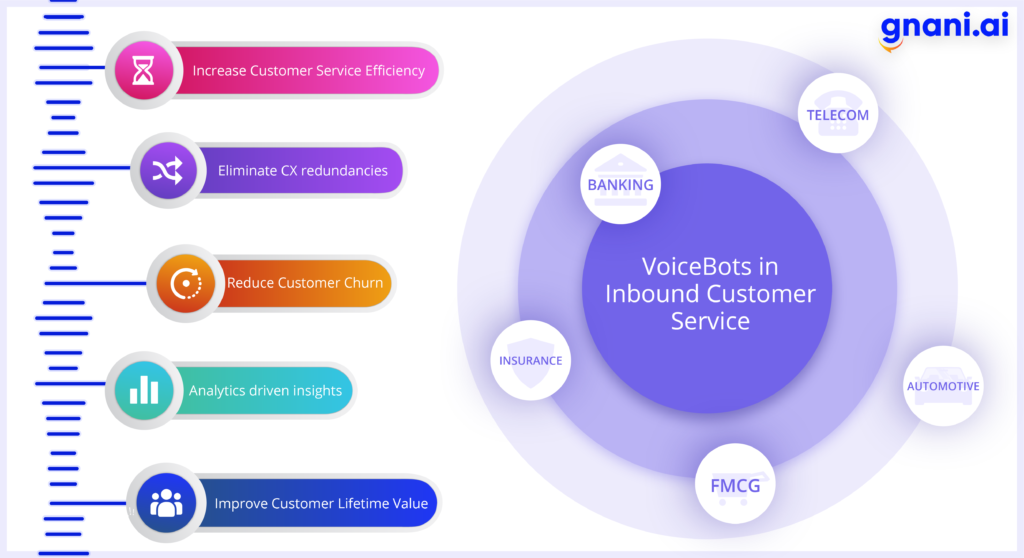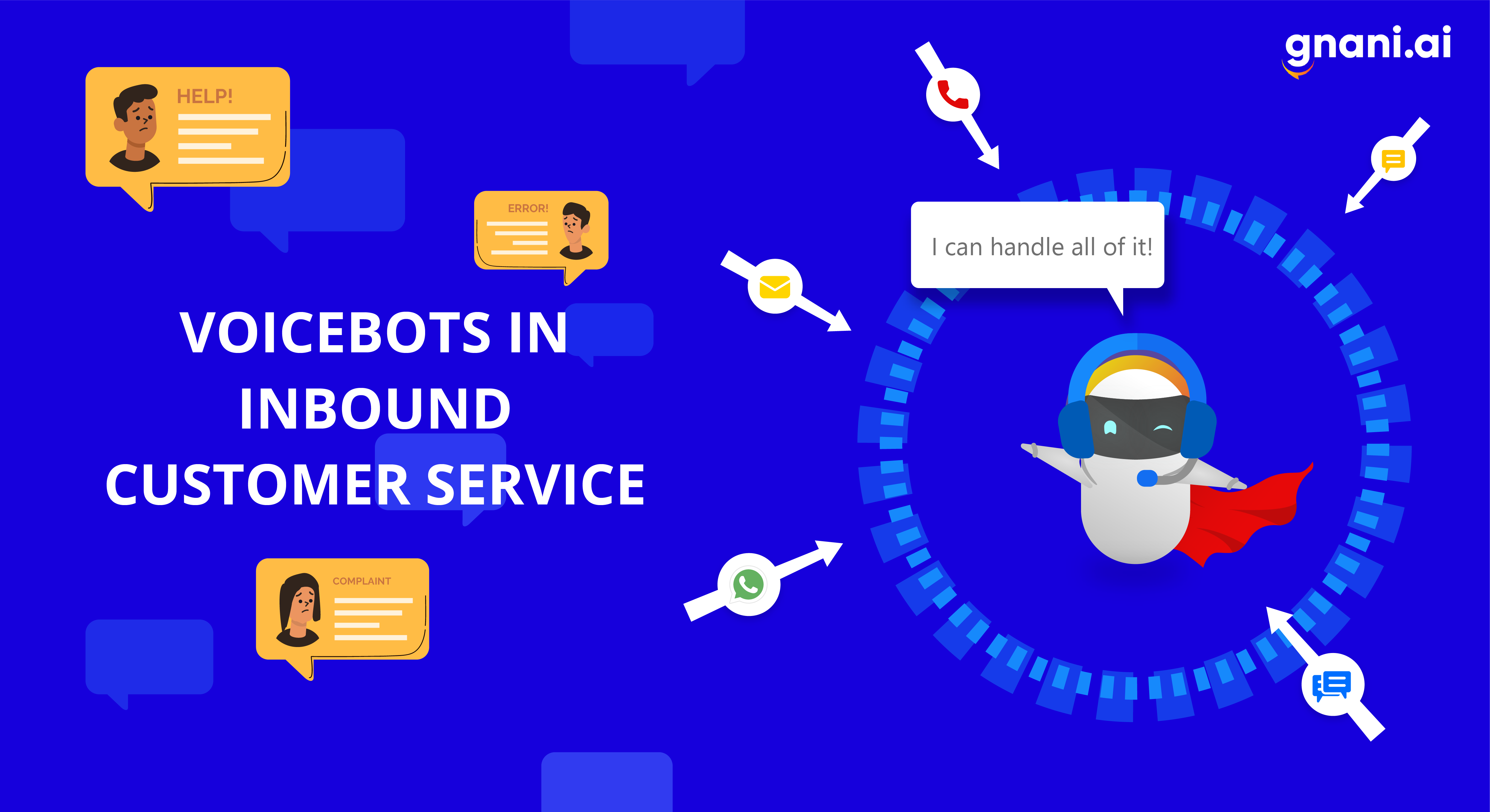Sales of voice-activated smart speakers exceeded 150 million units in 2020, showing that voice-assistance-based customer experience solutions are now firmly entrenched in the consumer space. The natural next step is to offer inbound customer service via intelligent conversational AI assistants like voicebots.
Chatbots are already prevalent with 80% of customers reporting positive interactions. Adding a voicebot solution to the customer service pipeline of a business ensures 24/7 omnichannel availability.
A Hubspot survey indicates that 40% of customers don’t care whether they receive assistance from an AI tool or a live agent when they contact customer support, as long as their problem is resolved satisfactorily. Using voicebot solutions in inbound customer service improves CX comparable to non-automated services.
Benefits of Voicebot Solutions
Increase Customer Service Efficiency
69% of respondents in a Cognizant survey preferred conversational bots to get instant responses from a website. Speaking of instant responses, AI voice bots are a better alternative to interactive voice response (IVR) calls. Most customers want to bypass the IVR system to contact human agents. Voicebots can help to reduce the waiting time, and the frustration experienced by the customers when they contact any support desk.
Unlike a human agent, a voice bot can recall the entire interaction history with a customer and even draw upon similar precedents within seconds. It can, therefore, resolve the problem accordingly or quickly transfer to a trained human agent for more intelligent conversations.
Voicebot solutions should be added to teams of specialists that leverage human abilities and AI insights to deliver superior service. The future of customer service is personalized, timely, and omnipresent and voicebot solutions have a major role to play in it.
They should be added to teams of specialists that leverage human abilities and AI insights to deliver superior service. The future of customer service is personalized, timely, and omnipresent and voicebot solutions have a role to play in it.
Eliminate Customer Experience Redundancies
Customers are often made to explain their queries to different agents at each level of the query resolution process when they contact the customer support department. Fragmented customer journeys are frowned upon in today’s competitive markets. Voice-activated AI tools can provide a seamless experience across channels, allowing customers to pick up the conversation where they left off every time they contact the support team for the same query; such as starting from a chatbot and being transferred to a voice bot.
Voicebots can even perform tasks like making appointments. They can take over repetitive queries such as FAQs and free up agents to handle more pressing issues requiring complex problem-solving. Gnani has demonstrated a 5X increase in appointments with their customer service appointment AI assistant.
Reduce Employee Attrition Rate
Customer service is known to be a challenging space with high attrition rates. Competent professionals exit quickly for greener pastures as the tedium and unpredictable customer behaviour diminish morale over time. Contact Centers have high operational costs for answering inbound queries due to these manpower needs.
Voicebots can reduce these tiresome aspects of repetitive customer interaction and free up human agents to handle more cognitively demanding tasks. Contact Center professionals can be trained to analyse the data generated to further improve the customer experience. Ensuring a dynamic career may reduce CX attrition rates from the current 30-45%.
Improve Customer Lifetime Value
About 33% of customers are likely to switch brands after one bad customer service interaction. This is why eight out of ten businesses surveyed by Oracle have or are planning to integrate voice bot solutions in customer service.
In some industries like banking and insurance, 24/7 customer support is the norm, and using voice bot support for that can help reduce the costs. The bots don’t tire of repetitive queries, providing a consistent and positive customer experience and helping to increase CLV (Customer Lifetime Value).
The insights derived from the analytics data generated by voicebots can be used to identify cross-selling or upselling opportunities and pass them onto the sales and marketing teams to increase CLV by crafting personalized offers and deals.
Provide Analytical Advantage
CX professionals have to recall interactions with customers accurately and record them with minimal bias. However, voice-based conversational AI greatly simplifies this by using NLP and voice recognition. The analytics suites gather conversation-related metrics like sentiment, FAQs, churn propensity, etc.
The data can be used to segment and personalize the inbound service approaches and predict emerging issues that the bots should be trained to head off.
Use Cases: Putting Voicebot Solutions in Action
The best way to conceptualize how voicebots can play a role in inbound customer service is to consider some real-life use cases where they can be put into action.

Banking
Imagine that an impatient customer is calling to have his stolen credit card blocked and he is put through the rigmarole of a long-winded IVR message. In the end, he is almost shouting at the live agent.
A voice bot could have handled this entire interaction in a fraction of the time taken. It can also handle preliminary customer inquiries about banking products. Without an AI assistant to receive the query immediately, the customer might end up changing his mind!
Automotive Companies
Nurturing customers throughout the long journey as a car buyer requires superior customer support. Increasing the CLV and maintaining a good relationship can get the customer to return and purchase the next vehicle.
Voice bot solutions can automate tedious tasks like simple service queries, booking service appointments, test drives, etc. and help the company to ensure a good service experience to its customers. Gnani’s voicebots also have vernacular language support, a growing necessity as non-English speaking customers are becoming an important segment.
Dealing with Complaints
This is perhaps the most significant area where voice bot solutions are likely to bring about a radical shift. 72% of customers report having to explain the problem to multiple representatives and being unhappy about this. Unfortunately, instances of customers being polite when they are annoyed by performance problems are much less common than irate ones demoralizing the human executives. 35% of customers report having lost tempers when dealing with customer service executives.
Voice-based conversational AI is by design, perfectly equipped for this purpose. Not only can they listen to endless tirades, but they can also provide objective data about customer sentiments.
Call Centers
Bots for a call center business implement natural language processing to recognize the semantics of human voice. It includes canonical, grammar, synonyms and other word forms.
Generally, customers to a call center are not fully aware of the words they speak while talking. NLP helps voice bots to identify the intent of uttering a particular word. For example, when a customer says sure, the bot should understand that it is a yes.
An intent analysis is one of the crucial characteristics of a voice bot for a call center business.
Conventional IVR prompts customers to go through many other unnecessary options, thus making the customers wait for calls to get diverted to the right agent at a call center. When customer inquiries are handled quickly by the voicebots, it turns into an incredible opportunity. Hence, voice bots help the call center to generate revenue and make more profits over time.
A call center bot can communicate with thousands of customers at a time. Hence, it offers customized services to all. Service providers manage multiple support issues which would otherwise be impossible by eliminating repetitive tasks handled by call center agents. Voice Bots for call centers reduce costs as well. It ensures a fast, active and smooth experience to the customer.
Why Voicebots should be a part of Inbound Customer Service Strategy
Salesforce research tells us that 78% of customers will continue to do business with a company even with mistakes, if the service is excellent. Hence, it is important to make your service excellent first.
It is advised to implement conversational voicebots alongside human agent support in your inbound customer service strategy to ensure that your business is one of the businesses these people return to. Conversational voicebots understand natural speech and figure out what a customer needs. They can transfer calls to human agents without customers having to repeat themselves when more challenging questions need human help to resolve, resulting in smooth and seamless customer conversations over digital voice channels.
We’ll conclude with a note about the top benefits of voicebots in inbound customer service are the scalability and cost savings. It’s relatively less expensive to get voice bot support when you have to expand your customer service team.
Reach out to us to understand the potential of voice bots in inbound customer service automation.
Frequently Asked Questions
How does a Voicebot work?
A voicebot enables its user to interact with a device or a service simply by speaking. Powered by artificial intelligence and Natural Language Processing (NLP), a voicebot can understand a spoken question or request and structure a fitting audio response.
How long does it take to implement Voicebot?
It depends on the complexity of the solution you need. Certain voicebot solutions with basic functionality can be implemented within a few days. However, there are certain professional voicebot solutions with conversational scenarios featuring multiple sequences of events/replies, renewable keyword vocabulary, which can work with rejections and negative reactions, features machine learning algorithms and comprehensive reporting. They can consult in multiple areas, understand multiple intents and their implementation may take 3-5 weeks.
Can Voicebot replace a real consultant?
A voicebot is great at automating repetitive tasks, e.g. pre-qualification interviews during mass hiring, booking appointments, pre-qualification of requests in customer support or addressing common queries and requests at a call center. It can also automate CRM/HRM system management and reporting. Having a voicebot support saves time, prevents a real agent from burning out and allows him/her to concentrate on tasks requiring creativity and higher qualification, which in turn increases overall performance of the team.


